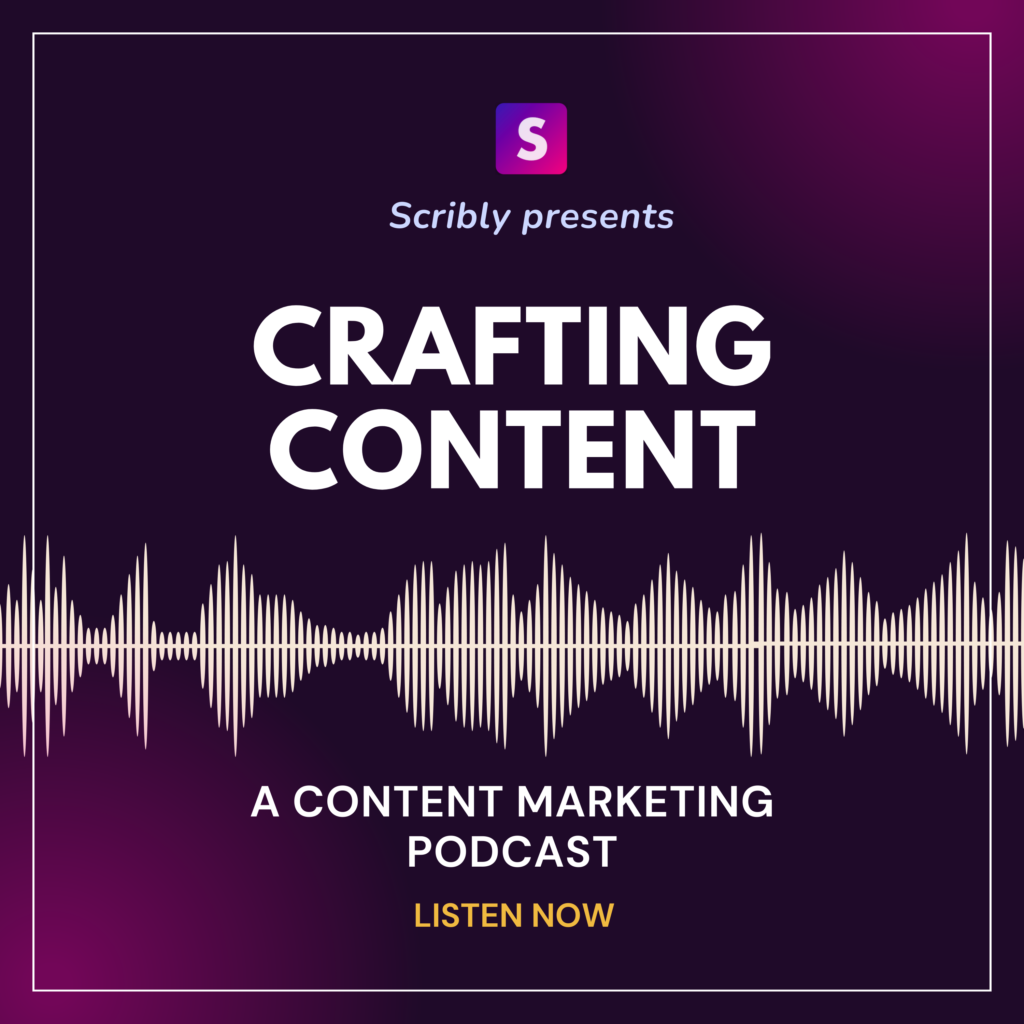Crafting Content – A content marketing podcast from Scribly
Crafting Content episode 1: Filling the funnel
Welcome to the first episode of Scribly’s new content marketing podcast, “Crafting Content“. Designed to share Scribly and our team’s vast amount of content marketing knowledge, each episode will include insights, top tips, and real-world examples to help you develop your content marketing skills.
Our first mini-series explores common content marketing mistakes and (most importantly) how to avoid them. The first topic is about focusing too heavily on upper-funnel content and disregarding mid- and lower-funnel content. We explore each phase of the marketing funnel, including the awareness, interest, and conversion phases, what the prospect is looking for during each phase, and how to tailor your content to their needs and thoughts.

You can listen to the full episode here: Scribly’s Crafting Content Podcast: Episode 1 – Filling the Funnel
Episode 1: Filling the funnel (transcript)
Taylor: Hello and welcome to the very first episode of the Scribly podcast, Crafting Content.
Hi, I’m Taylor. I work at Scribly. I’m a Content and Account Manager. Welcome to the podcast! With me today is Elle, Scribly’s Head of Content, and we’re going to talk about content marketing.
Elle: Hi, Taylor. It’s nice to join you here.
Taylor: For everyone listening, Scribly is an end-to-end content marketing agency. We can help you with all your content and content marketing needs.
We like talking about content and learning how to do our jobs well, and then passing the things that we learn on to the people that we meet. That’s what this podcast is going to be—little insights that we’ve encountered in our careers and while working with clients here at Scribly. Things we found interesting or helpful that we want to share with all of you.
With that in mind, what are we talking about today, Elle?
Elle: The first thing that we wanted to chat about was all of the content marketing mistakes we’ve seen. Scribly’s existed since 2018, so we’ve worked with many clients over the last five years and we’ve seen the good, the bad, and the ugly.
Between us, we have a lot of experience from other companies, and there are recurring mistakes that we see time and time again that are avoidable and impact the quality of content that people deliver. If you can be aware that you’re making these mistakes and know what to look for and how to fix them, it can help a business improve the quality of their content quickly.
The place that I wanted to start when we’re talking about content marketing mistakes is with the misconception a lot of people have about content marketing: that we produce content to entertain, like fun blog content or social media, but content marketing has a lot more depth to it. It’s used throughout the marketing funnel, as opposed to being used as a tool to attract and entertain potential new customers. I think companies tend to focus too much on top-of-funnel content, as opposed to having an in-depth content marketing strategy that touches on the different levels of the funnel.
Taylor: You’ve mentioned the funnel. What is that?
Elle: There are three or four levels to a marketing funnel. If you think about a customer’s journey from the moment they think that they have a problem to the moment that they make a purchase to solve that problem. In B2C, the idea is that you have a product that you can sell to that customer that will resolve that problem.
You’ve got the awareness phase, the interest phase, and then the purchase phase.
In that first phase of awareness, typically from a business’s perspective, you’re looking to attract a new customer, but the goal of that customer at this stage is purely to learn. They have no intention to make a purpose. They’ve got a problem. They’re not really sure how to solve it or what it is. They’re essentially looking for information to help them understand, frame, and define that problem and put it into context.
To give you a really good example, someone might search for “Why is my skin so itchy?”. At this stage, they’re not looking to purchase a product to solve that problem. They’re looking to put a name against the thing that’s causing itchiness.
As a business, you’ll create top-of-funnel content or awareness stage content that’s going to help them answer that question. You might write a blog or a white paper that talks about symptoms or triggers of itchiness, something like “10 possible causes of itchy skin”, or you might post a video about it or a social media carousel. Just something that’s going to help them understand the root cause of their itchiness. That’s phase one: awareness.
Taylor: If a Scribly client wanted to create content because a lot of their customers were just itchy all of a sudden, then I might pitch them a blog post about “Why your skin dries out when the weather gets colder”. That would be top-of-the-funnel content.
Elle: Exactly. You’re helping them understand a problem that they have without actually actively selling them anything. And if you host it on your blog, obviously they’re going to become a little bit aware of your company and who you are because they’ve landed on your page. It’s kind of the point of the awareness phase, but it’s not sales-driven at this stage.
Taylor: Then what’s next after that stage?
Elle: Let’s say yesterday you googled “Why do I have dry itchy hands?” and you find out that the main cause of that is dehydrated skin or psoriasis or whatever the cause might be. You’re now at a point where you’re looking for a solution to that problem.
Here, we move into what we call the interest phase, which is all about nurturing the customer and their desire to dive deeper into that research. Now they know that the cause of their itchiness is dry skin, they might want to know “How do I get rid of my dry skin?”. Or, “What’s the best product to hydrate dry skin?”.
That then allows a brand to offer expert advice that’s going to solve that problem. This is your opportunity to start introducing your product or your service as a solution that will meet their needs. So, you might have a buying guide.
Taylor: A guide? What might that look like?
Elle: You might dive into the best hydrating products and what each of those do. You might dive into more specific products, like a product category. They might just want to know that they have options in terms of products that hydrate their skin. It might be a serum, a day cream, or a night cream. You could build a guide that explains what each of those products is and what steps they cover within skin care.
You might also have a guide that deep dives into one product specifically. If you’re talking about moisturizers, you could explain the difference between a water-based one, a gel one, an oil one, an SPF one, etc.
All of this is going to help them figure out which is the best product for them. Then, you might insert within that guide a link to a product that you sell that covers those needs. So you’re gently nudging them towards your product and making them aware that it is a potential solution if that’s right for them.
Taylor: Okay. So your customers now see your product or specific types of products as potential solutions to their problem. That’s the interest phase. What happens next?
Elle: Then we move into what’s known as the purchase phase, which is essentially when they’re ready to make a purchase and they know what product they want.
If we go back to our example about moisturizers, let’s say they’ve decided that an oil-based moisturizer is the right product for them. Now, they’re going to look more specifically at which oil-based moisturizer.
You’re going to create a wealth of content—which is very product-focused—and this is where it gets a lot deeper than just a guide or a blog post. We need to start looking at web copy and what that conversion phase looks like. The likelihood is that customers will go and explore websites, looking at product pages, FAQs that are going to answer questions they have about the product, or tutorials about how to use it.
What I found has been successful is having before and after images, or results from other customers who’ve used the products. Seeing statistics that say “90% of people who tried this product experienced more hydrated skin after two weeks”—or whatever other claim they can make—is really powerful. You can share those before and after images on social media and create very shareable content. You could share reviews and customer testimonials, or even a blog that explains specifically how to use that product. There’s a lot of content to be created at this phase but it becomes a lot more site-focused because you want them to click on that “by now” button and make the purchase.
Taylor: Right, it’s not just about telling people that your product exists in the world, but more guiding them into where and how they too can experience the benefits that your product has to offer.
Elle: Exactly. And helping them to see the value in purchasing it.
Taylor: Makes sense to me. I’m now like “Great, let’s find me a hand moisturizer.” And it makes total sense, right? Because once you’ve identified your problem and how to fix it, you go to Google and search “SPF-based moisturizers” or for reviews of a certain brand name that you’ve heard of. It makes sense to have that widespread content that can address any number of different search queries or questions that your potential customers might have.
Elle: Exactly. You’re kind of guiding them through every single stage of 1) I just want some info about what this could be too, 2) Okay. I have this problem. 3) This is the solution to my problem. 4) This is the specific product for that problem.
Taylor: And if—and this is a content marketing mistake that we’ll talk about a little bit later in this little series—your content is well linked internally, then you could send someone on the different stages of the journey from one piece of content to another. There are lots of layers here.
Elle: Yeah, it’s something that gets overlooked too often in terms of how each piece fits into the puzzle so that you can have an overarching view. It’s important to have a strategy right from the get-go which includes: mapping what a customer journey might look like, what type of content they’re going to engage with at each of those stages, what type of content you’re going to create, and how you’re going to link it together across your social channels and various content marketing touch points. If you can start by looking at things a lot more broadly, then you can be a lot more targeted with your approach.
Taylor: Makes sense. We should all be considering every stage of the funnel, not just that first awareness stage.
That’s the first big mistake that we see often. We will be back with more mistakes in future episodes. Thank you all very much for listening, and you can get in touch with us through the Scribly website, scriblymedia.com.
If you have any content marketing burning questions that you want answered on the podcast, drop us a message there and let us know. We will be back for another episode soon.
Thank you for listening to Crafting Content, a content marketing podcast from Scribly. You can find more information about what we covered today in our show notes. Scribly is a content marketing agency that helps you boost traffic, generate sales, and increase your bottom line. With our end-to-end service, we take care of everything from content audits and strategy to content creation and management across websites, blogs, socials, and email.
We’re a small but mighty team of experienced strategists and marketers who specialize in content creation. If you want to learn more about how Scribly can help your business, please get in touch. You can find more information and send us a message on our website, scriblymedia.com. We’d love to hear from you.




